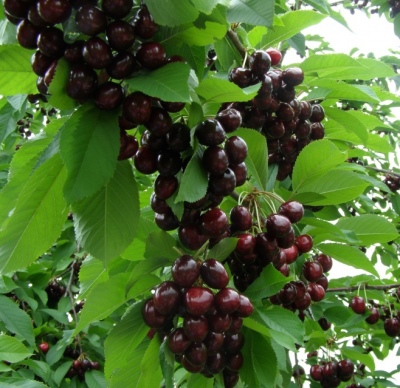
- Fruit shape: heart-shaped
- Foliage: good
- Authors: Belarusian selection
- Appeared when crossing: Sweet cherry Pashkevich x mixture of sweet cherry pollen
- Growth type: medium-sized
- Appointment: for fresh consumption
- Tree height, m: 4-5
- Crown: wide pyramidal, raised
- Fruit size: medium
- Fruit weight, g: 5,2
Cherry Narodnaya is a self-pollinated variety that is able to form a decent harvest even in regions of risky farming. Due to the high taste characteristics of juicy fruits, they are successfully used both for fresh consumption and for making winter desserts and homemade drinks. The unpretentious culture has a stable level of fruiting and high fruit quality.
Description of the variety
Cherry variety Narodnaya is the result of painstaking work of breeders-practitioners of the Belarusian Research Institute, and especially its employee E.P. Syubarova. The plant was obtained by combining the genetic material of Pashkevich's cherry and a combination of pollen from several sweet cherries.
This variety is suitable for growing in various climatic latitudes, including the central and middle regions of Russia, which are characterized by unfavorable climatic conditions and low temperatures. Adult plants are capable of producing about 20 tons of fruit on a 1 hectare plot. Sweet and juicy berries are in demand both among lovers of fresh fruits and housewives who make aromatic winter preparations.
The plant belongs to medium-sized crops, in which the average height of the central trunk is about 4-5 meters. The cylindrical raised crown has a strong structure and a large number of branches with abundant green mass. Thanks to the strong timber frame, the tree is able to withstand strong gusts of wind without damage, as well as retain significant amounts of snow.
Due to their unpretentiousness, cherry seedlings feel comfortable not only on fertile soil, but also on loamy and sandy loam.
The thick wood covering of the trunks reliably protects the plant from winter frosts and small pests.
Advantages:
- resistance to temperature fluctuations;
- resistance to low temperatures;
- undemanding to watering;
- unpretentiousness to soil composition;
- resistance to the most common diseases and pests;
- high level of keeping quality and transportability;
- preservation of the integrity of the fruit in any climatic conditions.
The disadvantage is the lack of over-harvest.
Fruit characteristics
The fruits of the sweet cherry are of average size with an average weight of 5.2 grams. The color range of berries is from dark red to deep burgundy glossy shade. The fruit is shaped like a heart. A small bone separates well from the pulp, which significantly increases the demand for this variety. The fleshy part of the fruit is rich red, juicy, sweet and moderately dense.
The fruits are practically not subject to deformation and cracking, even in the presence of excessive precipitation in the region and under conditions of maximum temperature conditions. This property has a positive effect on the keeping quality and transportability of the crop.
Taste qualities
The fruits have excellent taste characteristics. Moderately dense fleshy berry is distinguished by its juiciness, sweetness and delicate aroma.
Ripening and fruiting
The flowering of a fruitful, unpretentious variety begins in the last days of May, and the technical ripeness of the fruits begins in the first decade of July. A young tree can please its owner with a harvest already 4 years after planting.

Yield
Cherry Narodnaya is distinguished by stable fruiting under various climatic conditions. More than 50 kg of ripe fruit can be harvested from one mature tree. More than 95 percent of the berries reach the level of technical ripeness and are suitable for consumption and sale.
Self-fertility and the need for pollinators
Cherry Narodnaya belongs to self-fertile crops, however, to increase yields, experienced breeders recommend planting it next to the following varieties:
- Golden loshitskaya;
- North.
Growing and caring
Due to its unpretentiousness, the cultivation of Narodnaya cherries will not cause difficulties even for novice gardeners. Young seedlings easily take root in areas with any soil. When planting trees, you must follow the 5x3 scheme. The plantings should not be thickened. The most optimal time for planting is early spring or autumn. Planted young trees must be watered and fed.
Mature plants need regular sanitary and formative pruning, as well as preventive treatment against diseases and pests. There should be no accumulations of old leaves and rotten fruits under the trees, which are a favorable breeding ground for pathogenic bacteria.
If there is a large accumulation of rodents in the region, then before the onset of cold weather, it is better to overlay the lower part of the tree trunks with spruce branches.
Early whitewashing of tree trunks will help prevent the appearance of spring burns.




Disease and pest resistance
An unpretentious variety has a high immune resistance to most diseases and pests, including coccomycosis.

































































